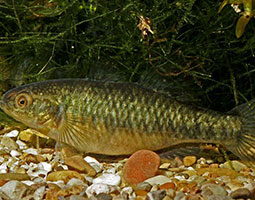Hypseleotris compressa
Description

Empire Gudgeon (Hypseleotris compressa) have a long body which can be up to a maximum of 12 cm in length. The females tend to be smaller than the males. Unlike most fish they do not have a lateral line. They have a wide variety of colourations but typically they have a yellow to dark-brown head and a pale–red underbody. They also possess 7 or 8 vertical bands. Outside breeding seasons, males can be distinguished by their prominent forehead hump and conspicuous, variously coloured bars on their fins. The caudal fin tends to be dull-brown in colour, and the pectoral and pelvic fins lack any colour. When breeding season begins, the males brighten significantly, becoming vibrant red-orange in colour. Colour changes in this species of fish can often be extremely rapid.
Breeding and spawning occurs from January to March with females laying up to 3000 small eggs (0.26-0.32 mm in diameter) every 2-7 days in long rows. The eggs then adhere to sand, rocks and aquatic vegetation which are then guarded by the male. After about two weeks the larvae hatch and are swept downstream to the estuaries where they develop prior to migrating back upstream when they reach maturity.
Empire Gudgeon are distributed from the Murchison River in Western Australia around the northern coast of Australia to the Nadgee River in New South Wales, this includes the Torres Strait islands. The species also has populations in the southern parts of Papua New Guinea. Within this range it inhabits the lower reaches of slow-flowing coastal rivers and creeks, swamps, lagoons, and even the upstream regions of estuaries. These fish prefer waters that are flowing, and hide around aquatic vegetation, sub-surface timber and the crevices and cracks of rocks.
Adaptations
- Omnivorous feeding strategy
- Tolerant of high salinities
- Tolerant of water temperatures up to 35ºC and somewhat acidic to alkaline waters with a pH 5.0-9.1
Feeding relationships
- What I eat: small crustaceans, aquatic insects, plant matter and detritus
- What eats me: carnivorous fish, birds (e.g. Egret), turtles, large predatory insects (e.g. water scorpion)
Interesting facts
Research has shown that Empire Gudgeons are great natural options for controlling mosquito populations as they are readily eat the larvae of the common banded mosquito.